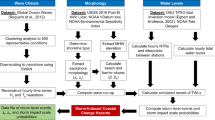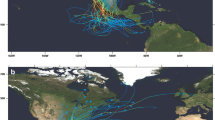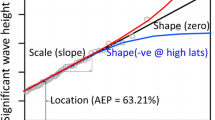Abstract
Model-derived wave height data for points along the eastern Lake Ontario shoreline provide the basis for a 36-year climatology of extreme wave heights. The most extreme wave heights exceed 6 m at all locations, except for those along the extreme northeastern shoreline of the Lake. Typically extreme wave events are a regional phenomenon, affecting multiple locations along the eastern and southeastern shoreline. A pronounced seasonal cycle in wave event occurrence is characterized by peaks in autumn and spring, with an absence of 99.9th percentile wave heights during summer. Less extreme (90th percentile heights) occur in all months with a peak in winter. Extreme wave events are most often associated with a low pressure center tracking to the north of Lake Ontario from the Ohio Valley. This track produces the strong winds > 10 ms−1 and predominantly west-to-east wind fetch that characterize high wave height events. The seasonal frequency of the wave events exceeding the historical 95th percentile has shown a statistically significant increase at most locations since 1979. This has been partially offset by declines in the frequency of events with wave heights between the 90 and 95th percentile. Seasonal extreme wave height frequency is also found to be related to the occurrence of El Niño. During El Niño winters, there are significantly fewer events with wave heights exceeding 2.5 m than would be expected by chance. A corresponding relationship to La Niña occurrence is not evident.










Similar content being viewed by others
References
Amin SMN, Davidson-Arnott RGD (1997) A statistical analysis of the controls on shoreline erosion rates, Lake Ontario. J Coastal Res 13:1093–1101
Angel JR (1995) Large-scale storm damage on the U.S. shores of the Great Lakes. J of Great Lakes Research 21(3):287–293
Angel JR, Isard SA (1998) The frequency and intensity of Great Lake cyclones. J Clim 11(1):61–71
Bengtsson L, Hodges KI, Roeckner E (2006) Storm tracks and climate change. J Clim 19(15):3518–3543
Booij N, Ris RC, Holthuijsen LH (1999) A third-generation wave model for coastal regions: 1. Model description and validation. J Geophys Res 104(C4):7649–7666. https://doi.org/10.1029/98JC02622
Castedo R, Fernández M, Trenhaile AS, Paredes C (2013) Modeling cyclic recession of cohesive clay coasts: effects of wave erosion and bluff stability. Mar Geol 335:162–117
Colle BA, Zhang Z, Lombardo KA, Chang E, Liu P, Zhang M (2013) Historical evaluation and future prediction of eastern north American and western Atlantic extratropical cyclones in the CMIP5 models during the cool season. J Clim 26(18):6882–6903
Colucci SJ (1976) Winter cyclone frequencies over the eastern United States and adjacent western Atlantic, 19641973. Bull Amer Meteor Soc 57:548–553
Eichler T, Higgins W (2006) Climatology and ENSO-related variability of north American extratropical cyclone activity. J Clim 19(10):2076–2093
Farhadzadeh A, Hashemi MR, Neill S (2017) Characterizing the Great Lakes hydrokinetic renewable energy resource: Lake Erie wave, surge and seiche characteristics. Energy 128:661–675
Hirsch ME, DeGaetano AT, Colucci SJ (2001) An East Coast winter storm climatology. J Clim 14(5):882–899
Hofherr T, Kunz M (2010) Extreme wind climatology of winter storms in Germany. Clim Res 41(2):105–123
International Joint Commission (1993) Levels reference study: Great LakesSt. Lawrence River Basin. Final Report, Levels Reference Study Board, Ottawa, Ontario, 108 pp
Kilibarda Z, Shillinglaw C (2015) A 70-year history of coastal dune migration and beach erosion along the southern shore of Lake Michigan. Aeolian Res 17:263–273
Komen GJ, Cavaleri L, Donelan M, Hasselmann K, Hassel-mann S, Janssen PAEM (1994) Dynamics and modelling of ocean waves. Cambridge University Press, New York, p 532
Mackey SD (2012) Great Lakes nearshore and coastal systems. U.S. National Climate Assessment Midwest Technical Input Report: Coastal Systems Sector White Paper, 14 pp. http://glisa.msu.edu/docs/NCA/MTIT_Coastal.pdf
Mattheus CR (2014) Climate-induced changes in rates of headland-beach progradation along the southern coast of Lake Erie. J Coast Res 30(4):743–755
McCombs MP, Mulligan RP, Boegman L, Rao YR (2014) Modeling surface waves and wind-driven circulation in eastern Lake Ontario during winter storms. J Great Lakes Res 40:130–142
Meadows GA, Meadows LA, Wood WL, Hubertz JM Perlin M (1997) The relationship between Great Lakes water levels, wave energies, and shoreline damage. Bull Amer Meteorol Soc 78(4):675–682
Mesinger F et al (2006) North American regional reanalysis. Bull Amer Meteor Soc 87(3):43–360. https://doi.org/10.1175/BAMS-87-3-343
Nadal-Caraballo NC, Melby JA, Ebersole, BA (2012) Statistical analysis and storm sampling approach for lakes Michigan and St. Clair, Great Lakes coastal flood study, 2012 Federal Inter-Agency Initiative (No. ERDC/CHL-TR-12-19). Engineer Research and Development Center, Vicksburg MS Coastal and Hydraulics Lab [Available Online http://www.dtic.mil/get-tr-doc/pdf?AD=ADA569629]
Null J (2011) El Niño and La Niña years and intensities based on Oceanic Nino index (ONI). Accessed January 2016. [Available online at http://ggweather.com/enso/oni.htm]
Resio D, Perrie W (1989) Implications of an f −4 equilibrium range for wind-generated waves. J Physical Oceanography 19:193–204
Saha S, Moorthi S, Pan HL, Wu X, Wang J, Nadiga S, Tripp P, Kistler R, Woollen J, Behringer D, Liu H (2010) The NCEP climate forecast system reanalysis. Bull Am Meteorol Soc 91(8):1015–1057
Sayers M, Fahnensteil GL, Shuchman RA, Whitley R (2016) Cyanobacteria blooms in three eutrophic basins of the Great Lakes: a comparative analysis using satellite remote sensing. Int J Remote Sens 37:4148–4171
Swenson MJ, Wu CH, Edil TB, Mickelson DM (2006) Bluff recession rates and wave impact along the Wisconsin coast of Lake superior. J Great Lakes Res 32:512–530. https://doi.org/10.3394/0380-1330(2006)32[512:BRRAWI]2.0.CO;2
Taylor KE, Stouffer RJ, Meehl GA (2012) An overview of CMIP5 and the experiment design. Bull. Amer. Meteor. Soc. 93:485–498
Voldoire A et al (2013) The CNRMCM5.1 global climate model: description and basic evaluation. Clim Dyn 40:2091–2121
Wilk DS (2011) Statistical methods in the atmospheric sciences. Academic Press, Burlington
Yin JH (2005) A consistent poleward shift of the storm tracks in simulations of 21st century climate. Geophys Res Lett 32:L18701. https://doi.org/10.1029/2005GL023684
Author information
Authors and Affiliations
Corresponding author
Rights and permissions
About this article
Cite this article
Grieco, M.B., DeGaetano, A.T. A climatology of extreme wave height events impacting eastern Lake Ontario shorelines. Theor Appl Climatol 136, 543–552 (2019). https://doi.org/10.1007/s00704-018-2502-9
Received:
Accepted:
Published:
Issue Date:
DOI: https://doi.org/10.1007/s00704-018-2502-9




